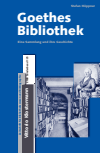Zusammenfassung
Stefan Höppners Buch widmet sich Goethes wichtigstem Arbeitswerkzeug – seiner Bibliothek. Sie ist nicht nur eine der prominentesten Büchersammlungen eines deutschsprachigen Autors, sondern auch als eine von wenigen Autorenbibliotheken um 1800 fast vollständig erhalten. Überdies ist ihre Entwicklung seit Goethes Tod außergewöhnlich gut dokumentiert. Auf der Basis teils unveröffentlichter Archivalien, der digitalen Neukatalogisierung der Bücher und Goethes Schreibspuren in den Bänden liefert dieses Buch ganz neue Einblicke in die Arbeitsweise und die Netzwerke des Dichters. Die Geschichte seiner Bibliothek handelt aber auch vom späteren Umgang mit der Weimarer Klassik, sowohl in der Forschung als auch in den politischen und kulturellen Institutionen vom Kaiserreich bis zur Gegenwart.
Abstract
Stefan Höppner's book is dedicated to Goethe's most important working tool - his library. It is not just one of the most prominent collections of books by a German-language author, but also one of the few authors' libraries from the time around 1800 to have been almost completely preserved. Moreover, its development since Goethe's death is exceptionally well documented. On the basis of partly unpublished archival records, the digital re-cataloging of the books, and Goethe's writing traces in the volumes, this book provides completely new insights into the poet's working methods and networks. The history of his library, however, is also about the later treatment of Weimar Classicism, both in research and in political and cultural institutions from the German Empire to the present.
Schlagworte
19. Jahrhundert Weimarer Republik Literaturgeschichte Kaiserreich Nationalsozialismus DDR Goethe Weimarer Klassik Autorenbibliotheken Büchersammlung Geschichte 1800–2000- 7–34 Einleitung 7–34
- 425–430 Ausblick und Dank 425–430
- 431–440 Abbildungsverzeichnis 431–440
- 441–484 Bibliographie 441–484
- 485–502 Personenregister 485–502

